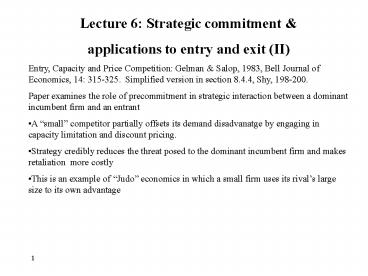Lecture 6: Strategic commitment PowerPoint PPT Presentation
1 / 7
Title: Lecture 6: Strategic commitment
1
- Lecture 6 Strategic commitment
- applications to entry and exit (II)
- Entry, Capacity and Price Competition Gelman
Salop, 1983, Bell Journal of Economics, 14
315-325. Simplified version in section 8.4.4,
Shy, 198-200. - Paper examines the role of precommitment in
strategic interaction between a dominant
incumbent firm and an entrant - A small competitor partially offsets its demand
disadvanatge by engaging in capacity limitation
and discount pricing. - Strategy credibly reduces the threat posed to the
dominant incumbent firm and makes retaliation
more costly - This is an example of Judo economics in which a
small firm uses its rivals large size to its own
advantage
2
- Model in General
- Homogeneous Products
- Incumbent is at least as efficient as entrant,
i.e., c1? c2. - Two-stage game
- Stage 1 Entrant chooses capacity (k2) price
(p2). - Stage 2 Incumbent chooses price (p1).
- If incumbent matches price, it takes the whole
market (and it has the capacity to serve the
whole market.) - Without capacity or if k2?, incumbent takes the
whole market.
3
- Incumbent has two strategies (I) Deter entry
(II) accommodate entry. - Deterrence profits ?D (p1p2) (p2-c1)D(p2)
- Accommodation Profits The incumbent chooses p1 gt
p2, and allows the entrant to sell all of its
output. The incumbent is then a monopolist on
the residual demand curve. (They assume
reservation-price rationing so that the entrant
gets the k2 consumers with the highest
valuation.) - ?A (p1-c1)D(p1)-k2 (where p1 is the
monopoly price)
k2
4
- Hence the entrant chooses so that ?D ? ?A.
- As p2 increases, ?D increases. As k2 increases,
?A decreases. - Thus there is a tradeoff between p2 and k2. If
the entrant chooses to large a capacity or too
high a price, the incument will respond by
deterring entry. - Hence the entrant underinvests in order not to
provoke a response from the incumbent. This is
an example of a puppy-dog strategy.
5
- Numerical Example
- Let P100-Q, and let c1c20.
- Hence D(p1)-k2 100- p1-k2
- Hence to find ?A, maximize p1 (100-p1-k2)
- FOC imply that p1 (100- k2)/2.
- Hence ?A (100- k2)2/4.
- ?D p2D(p2) p2(100- p2).
- ?A ?D implies that (100- k2)2/4 p2(100- p2).
6
- Solving yields p2 100-(200- k2)k2.5 /2.
- Clearly, there is an inverse relationship between
p2 and k2 for the entrant. - As increases, profits increase, but must fall to
insure that the constraint (?A ?D) holds.
Otherwise the incumbent will deter entry. - In the first stage, entrant maximizes ?E p2k2,
where p2 100-(200- k2)k2.5 /2. This needs
to be solved numerically.
7
- Finally we need to check that p2ltp1. Otherwise,
the entrant will not make any sales. - p2 100-(200- k2)k2.5 /2 lt p1 (100- k2)/2
implies - (200- k2)k2.5 gt k2, which implies
- (200- k2)k2 gt k22, which implies
- 200k2 gt 2k22, which implies
- 100 gt k2.
- This is true because demand function is P100-Q.

